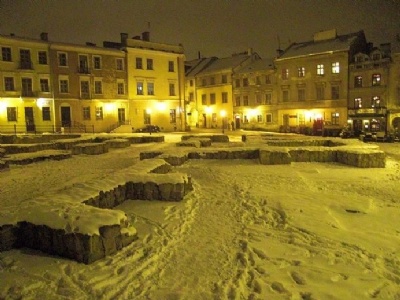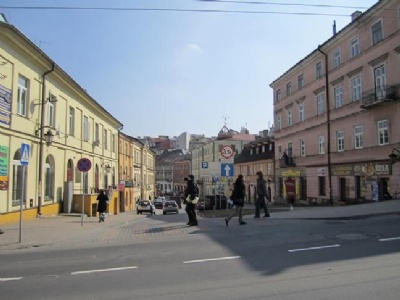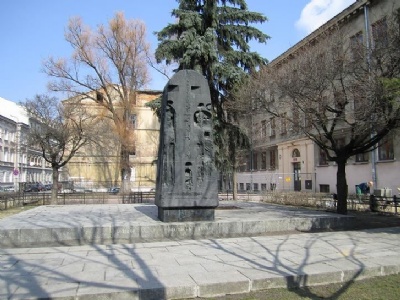Lublin Ghetto
In 1939 Lublin had approximately 122,000 inhabitants of which about 42,000 were Jews. The city had for centuries been a central place for Jewish culture and education. Before the war, there were twelve synagogues, about hundred Jewish prayer houses, three Jewish Cemeteries, a Jewish hospital, a home for Jewish orphans, jewish schools and two newspapers published in Yiddish. Jews of Lublin had influence in the city’s political, social and cultural life. Despite this, few grown up Jews were assimilated with the rest of the population and only about 1000 Jews spoke polish. The younger generations, however, were more assimilated and spoke fluent Polish.
On September 18, the German army entered Lublin and imposed anti-Jewish laws that isolated the jews and made it easier to confiscate Jewish property. In mid-October 1939, the Jews were forced to pay about 300,000 zlotys in compensation to the german army. The Germans carried out random arrests of Jews and forced them to clean up after the fighting and bombardment of the city. About 5,000 Jews left Lublin and went east to parts of Poland occupied by Soviet Union. On November 9, SS-Obergruppenführer Odilo Globocnik, arrived in Lublin as newly appointed Highest Police leader. On the same day, the Jews were ordered to leave their homes and settle in the Lublin’s Jewish old quarter. In connection with the move, the Jews’ property was confiscated.
In late November 1939, Governor-general Hans Frank ordered all Jews over ten years in the Government to wear a armband with the star of David visible. All Jewish shops should also be marked with the star of David clearly visible to everbody passing by or entered the shop. Himmler had also decided that the Lublin district (part of the General Government) would become a Jewish reservoar to which all Jews from the german empire would be deported. Between December 1939, and February 1940, tens of thousands of Jews were deported to Lublin district. The deportations were carried out by the SS who did not asked Hans Frank for his approval. Hans Frank opposed this and complained to Hermann Goering that the General Government was unable to receive all these Jews. As a result, the deportations were stopped. In March 1941, a ghetto was set up in the town’s Jewish quarter. But it was not until March 1942, that the ghetto was shielded off from rest of the town.
In early 1942, the ghetto was divided into two parts, ghetto A and ghetto B. Ghetto A was the largest and consisted of unemployed Jews and ghetto B housed several institutions that belonged to Judenrat (jewish council). However, it was easier to move between the ghetto and the outside world than it was in several other ghettos. Several Jews working in German industries were allowed to stay in their homes despite it being outside the ghetto. This made it easier to smuggle goods and supplies into the ghetto. Jews with special documents could move between the ghettos during specific times of the day. These milder restrictions made Jews from other ghettos fleeing to Lublin hoping for a better life. Although this was true in comparison, the overcrowding led to the spread of contagious diseases which lead to many deaths in the ghetto. And the risk of spreading outside the ghetto.
In December 1941, parts of the ghetto’s Jews were moved to Majdan tatarski just outside Lublin to build a new a camp (Majdanek). In early 1942, the ghetto was reorganized and at the same time the deportation of the ghetto Jews to the newly build extermination camp at Belzec, about 150 kilometres south of Lublin, started. Construction in Belzec started in November 1941, with the purpose to kill the Jews in Lublin district (and Galicia). A few days before the deportations began in mid-March 1942, all Jews who worked in german indistries got special stamps in their identification documents. This meant that they were exempt from deportations to Belzec and were transferred to ghetto B. The Jews who did not work were informed that they would be relocated and ordered to appear at a certain place for further transportation. From there they had to walk about three kilometers to a re-location place (umschlagplatz) where they were deported to Belzec and murdered.
Between mid-March and mid-April, some 26,000 Jews were deported from Lublin to Belzec. In addition to deportations, several residents of the ghetto were shot on the outskirts of Lublin. Later in 1942, the Jews of the ghetto were moved to an area in Lublin called Majdan tatarski near the Old Airfield labor camp. In this new ghetto, the living condition were disastrous. There was not enough housing for the people and therefore had to live outdoors. This new ghetto was shielded off and surrounded by barbed wire fences and the Nazis murdered unproductive or superfluous Jews on regular basis. Himmler ordered the ghetto’s Jews to be transferred to nearby Majdanek concentration camp in November 1942. The old ghetto in Lublin was demolished by the Nazis in 1943. Of Lublin’s 42,000 Jews, about 1,300 survived the war. About 200 to 300 remained in hiding until the Red Army arrived. A further 1000 survived the war by fleeing to Soviet territory. In 2009 there lived about 200 – 250 Jews in Lublin out of about 100 000 inhabitants.
Current status: Demolished with monument (2009).
Address: Niecala 1, 20-080 Lublin (monumentet).
Get there: Walk from central Lublin.
Follow up in books: Arad, Yitzhak: Belzec, Sobibor, Treblinka – The Operation Reinhardt death camps (1987).




Just outside the ghetto, the square remains on ul. Grodzka where the Jews were ordered to assemble before being marched off to the re-location place for further transport to Belzec. Near what was the main ghetto entrance a ghetto monument was erected. But sometime around the turn of the century, the city och Lublin decided to exploit the area where the monument stood and it would therefore be moved. For instance, a parking garage was planned to be built. This created strong Jewish reactions and Lublin agreed to a compromise to move the monument back when the construction was completed. The monument was moved about 400 meters to a secluded place on ul. Niecala right next to an elementary school. In 2011 the monument still stands on the temporary loacation and the construction of the garage has not yet started. If anything has happened since then, I don’t know.